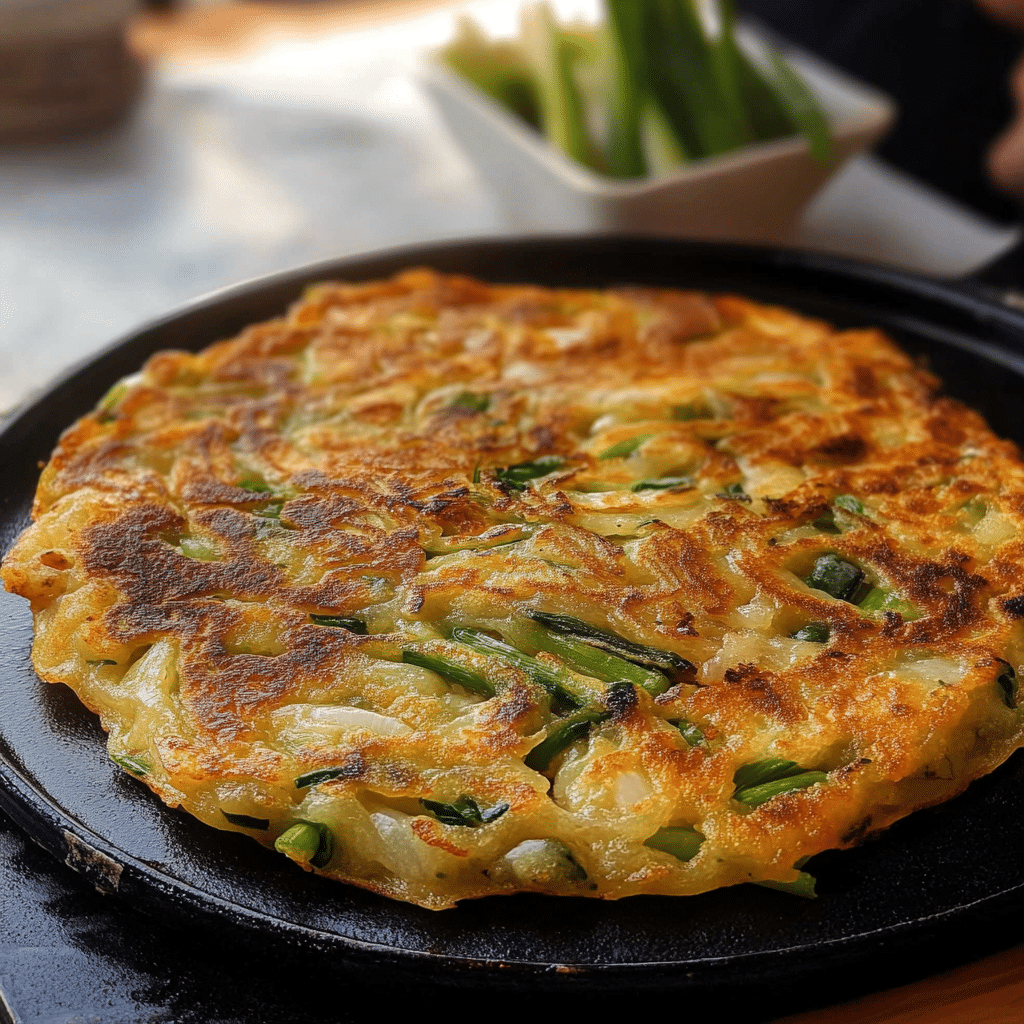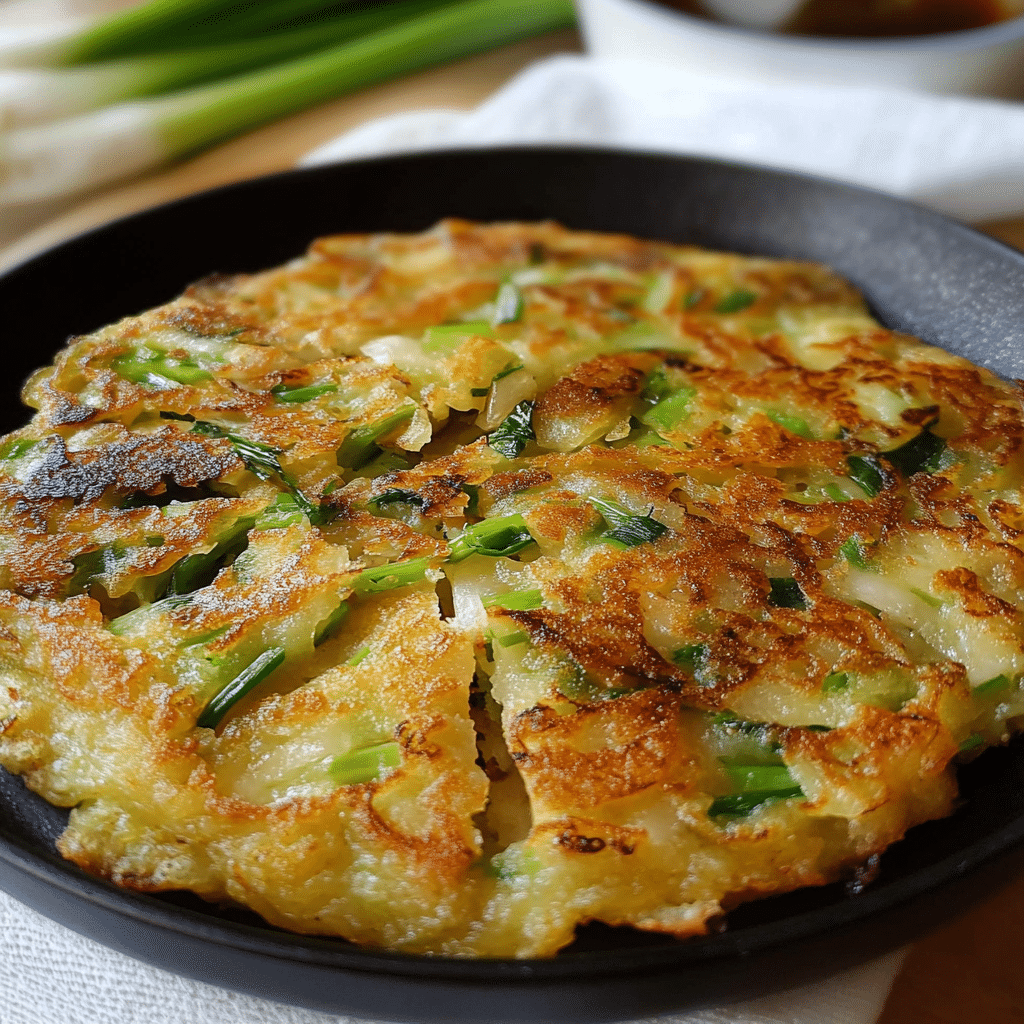
Discover the Kitchen Tool Everyone Is Raving About!
- • Precision Engineered: Sharp blade with durable craftsmanship.
- • Comfort First: Ergonomic design for effortless slicing.
- • Stylish & Strong: Elegant wood handle meets stainless steel strength.
- • Risk-Free Pick: Thousands of happy home chefs can’t be wrong.
- • Today’s Deal: Just $29.95 instead of $99.85 — limited-time offer!
This post may include affiliate links — learn more here .
Introduction
If you’re looking for a savory, crispy, and flavorful snack, look no further than Pajeon, a beloved Korean dish. Pajeon is a type of savory pancake made with a simple batter and packed with fresh scallions. While the ingredients are minimal, the taste is bold, satisfying, and a perfect introduction to Korean cuisine. This crispy, golden pancake is a delightful combination of textures and flavors, with the green onions offering a slight sharpness that complements the soft and chewy pancake base.
In this article, we will explore the unique aspects of Pajeon, why it’s such a popular dish in Korean cuisine, and provide a step-by-step guide on how to make this dish at home. Whether you’re a fan of Korean food or looking to try something new, Pajeon is a must-try that is sure to satisfy your cravings.
Why You’ll Love This Recipe
- Crispy and Chewy Texture: The combination of crispy edges and a chewy interior gives Pajeon its unique texture. The outer layer becomes golden and crunchy while the inside remains tender and soft.
- Savory Flavor: Packed with fresh scallions and seasoned with savory ingredients, this pancake is full of flavor without being too heavy or greasy.
- Quick and Easy to Make: With simple ingredients and an easy-to-follow process, this recipe is perfect for beginners or anyone in need of a quick snack.
- Versatile: Pajeon can be made with a variety of ingredients, and while scallions are the star, you can add other vegetables, seafood, or even meat to suit your taste.
- Halal-Friendly: This recipe is completely halal, meaning it contains no pork, bacon, or wine, making it suitable for those with dietary restrictions.
Preparation Time and Servings
- Total Time: 40 minutes (15 minutes for preparation, 25 minutes for cooking)
- Servings: This recipe makes about 4 servings, depending on how large you cut the pieces.
- Nutrition Facts (per serving): Calories: 250, Protein: 5g, Carbs: 30g, Fat: 12g.
Ingredients
For the Pajeon Pancake:
- 1 ½ cups all-purpose flour: Provides the base for the pancake batter. You can use whole wheat flour for a healthier alternative.
- 1 tablespoon cornstarch: Adds to the crispiness of the pancake.
- 1 teaspoon salt: Enhances the flavor of the pancake batter.
- 1 ½ cups cold water: The key to creating a smooth batter with the perfect consistency.
- 1 large egg: Helps bind the ingredients together and adds to the richness of the batter.
- 1 tablespoon sesame oil: Adds a nutty flavor to the pancake.
- 1 tablespoon vegetable oil (for frying): Used to fry the pancakes to a golden crisp.
- 1 bunch of scallions (green onions): The star of the dish. Chop them into 2-inch lengths.
- Optional: Other vegetables such as carrots, bell peppers, or zucchini can be added to customize your pancake.
- Optional: 1 small fresh chili (sliced) for a hint of heat.
For the Dipping Sauce:
- 2 tablespoons soy sauce: Provides the savory, umami base of the dipping sauce.
- 1 tablespoon rice vinegar: Adds a touch of acidity to balance the flavors.
- 1 teaspoon sugar: Enhances the sweetness in the sauce.
- 1 teaspoon sesame oil: For a nutty finish.
- 1 teaspoon gochugaru (Korean chili flakes, optional): For some spice.
- 1 teaspoon finely chopped garlic: Adds an aromatic kick.
- 1 teaspoon sesame seeds: For garnish and added texture.
Optional Protein Add-ins:
- ½ cup cooked chicken breast or beef (sliced thinly)
- ½ cup seafood mix (shrimp, squid, etc.)
Step-by-Step Preparation
First Step: MAKE THE BATTER
- Combine Dry Ingredients: In a large mixing bowl, whisk together the all-purpose flour, cornstarch, and salt. This dry mixture will form the base for your pancake batter.
- Add Water and Egg: Gradually add the cold water to the dry mixture while whisking to ensure the batter stays smooth. The cold water helps the pancake become crispy. Once combined, add the egg and sesame oil, continuing to whisk until everything is fully integrated into a smooth batter.
- Adjust Consistency: The batter should be slightly thick, but still pourable. If it’s too thick, add a little more water; if it’s too runny, add a bit more flour to thicken it. The right consistency will help the pancake hold together and become crispy.
Second Step: PREPARE THE SCALLIONS AND OTHER OPTIONAL INGREDIENTS
- Prepare the Scallions: Wash and chop the scallions into 2-inch pieces. They will add flavor and crunch to the pancake. If you like, you can also add other vegetables, such as carrots or zucchini, which you should julienne or chop into thin pieces.
- Optional Add-ins: If you’re using protein add-ins like chicken or seafood, make sure they are cooked and cut into small pieces. You can add them to the pancake batter later, or place them directly onto the batter as it fries in the pan.
Third Step: FRY THE PAJEON
- Heat the Pan: Heat a large non-stick skillet or frying pan over medium-high heat. Add about 1 tablespoon of vegetable oil, swirling it around the pan to coat the surface.
- Pour the Batter: Once the oil is hot, pour about 1 cup of the batter into the pan, spreading it evenly into a round shape. You can make the pancake as large or small as you prefer, but keep in mind that larger pancakes may take longer to cook.
- Add the Scallions: Immediately after pouring in the batter, sprinkle a generous amount of chopped scallions (and any other add-ins you’re using) over the top. Press them gently into the batter with the back of a spoon to ensure they stick.
- Cook the Pancake: Allow the pancake to cook for 4-5 minutes or until the edges become golden brown and crispy. Use a spatula to check the underside and ensure it’s cooked to a nice, even crisp.
- Flip the Pancake: Once the bottom is golden, carefully flip the pancake using a spatula. Cook the other side for another 4-5 minutes until it’s equally golden and crispy. If the pancake is thick, you may need to cook it a bit longer on each side to ensure it’s cooked through.
- Repeat: Remove the pancake from the pan and place it on a plate lined with paper towels to absorb any excess oil. Repeat the process with the remaining batter, adding more oil to the pan as needed.
Fourth Step: PREPARE THE DIPPING SAUCE
- Combine the Ingredients: In a small bowl, combine the soy sauce, rice vinegar, sugar, sesame oil, and gochugaru (if using). Stir well to dissolve the sugar and mix the ingredients thoroughly.
- Add Garlic and Sesame Seeds: Add finely chopped garlic to the dipping sauce for an extra burst of flavor. Sprinkle sesame seeds on top for added texture and to complete the sauce.
- Taste and Adjust: Taste the sauce and adjust the seasoning to your liking. You can add more sugar for sweetness, vinegar for tang, or gochugaru for spice.
Fifth Step: SERVE
- Slice the Pajeon: Once the pancakes are cooked and cooled slightly, slice them into wedges or squares.
- Serve with the Dipping Sauce: Serve the crispy Pajeon with the dipping sauce on the side. The savory sauce enhances the flavors and adds a delicious balance to the dish.
- Enjoy: Serve your Pajeon warm, paired with a hot cup of tea or a cold drink, and enjoy the crunchy, chewy, and savory delight of this Korean favorite.

How to Serve Pajeon
Pajeon is a versatile dish that can be enjoyed in many different settings. Here are some ideas on how to serve it:
1. As a Snack or Appetizer
Pajeon makes an excellent snack or appetizer for any occasion. Whether you’re hosting a gathering, enjoying a quiet meal at home, or preparing a picnic, Pajeon is always a crowd-pleaser.
2. Pair with Drinks
In Korea, Pajeon is often served with drinks, especially during social gatherings. Pair it with some chilled beer or a warm, comforting tea for a traditional experience. The crispy texture and savory flavors of Pajeon go perfectly with both alcoholic and non-alcoholic beverages.
3. As a Light Meal
Pajeon can also be enjoyed as a light meal. Serve it alongside a simple soup, like kimchi jjigae (kimchi stew), or with a fresh salad to balance the richness of the pancake.
Recipe Variations
While the classic Pajeon is made with scallions, there are plenty of ways to customize it:
1. Add Protein
You can easily turn Pajeon into a more substantial meal by adding cooked chicken, beef, or seafood. Shrimp, squid, or even fish cakes are common additions in Korean variations of Pajeon.
2. Vegetarian Version
For a vegetarian version, simply omit the meat and seafood, and add extra vegetables like carrots, bell peppers, or mushrooms.
3. Spicy Version
If you like spice, consider adding more gochugaru (Korean chili flakes) to the batter or dipping sauce. Fresh chilies can also be mixed into the batter for a zesty kick.
Tips for Perfect Pajeon
- Use Cold Water: Cold water in the batter helps to create a crispy texture. Avoid using warm water, as it can make the batter too soft.
- Don’t Overcrowd the Pan: Make sure not to overcrowd the pan when frying the pancakes. It’s best to make one pancake at a time, ensuring it gets evenly cooked and crispy.
- Use Non-stick Pans: A non-stick frying pan works best for cooking Pajeon, as it prevents the pancake from sticking and allows it to cook evenly.
- Serve Immediately: Pajeon is best enjoyed hot and fresh. While it can be reheated, it loses its crispiness after some time.
Conclusion
Pajeon is a wonderfully savory Korean pancake that offers a satisfying blend of textures and flavors. With its crispy exterior, chewy interior, and the delicious bite of fresh scallions, this dish is sure to become a favorite in your kitchen. Whether served as a snack, appetizer, or main meal, Pajeon is versatile and easy to make. Customize it with your choice of vegetables, proteins, or spices to suit your taste, and enjoy this simple yet delicious dish that’s perfect for any occasion.

